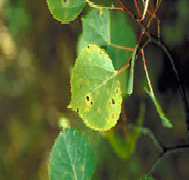Marssonina Blight
Marssonina blight is a disease of leaves that needs at least two fungi within the area, Marssonina brunnea and Marssonina populi. However, the infection is more commonly known as black leaf spot due to the way that it looks. Aspens are the most commonly infected hosts, but other poplars, such as cottonwoods, are also susceptible to suffering from it.
The damage with marssonina blight is mostly aesthetic. Repeated attacks can lead to branch dieback, other diseases, and winter injury. Other aspen tree care services include:
Knowing the Signs of Marssonina Blight
You’ll be able to see the early signs of the infection on the leaves. Brown spots will appear, but will soon expand across the whole leaf. You will usually find the infection grows in July or August, when the temperatures are higher and moisture in the air. Over time, the spots turn black and can have a white center with yellow outer sections. If the air is moist enough, the spots can develop blisters. You will also see the leaves fall off before the end of the summer. The whole leaf doesn’t even need to be infected. It just has to infect the petiole. As the summer continues, the infection will get worse. The infection spreads to other leaves. While the leaves will look brown, the colors aren’t as intense as they would be in the fall.
Highly Common Leaf Disease
Don’t be discouraged if you see Marssonina blight. This is one of the most common leaf diseases in the Rocky Mountains because of the weather. However, the severity can change from year to year, again because of the weather! Your trees are unlikely to die from the disease, unless there are other stresses or the condition is severe for a number of years. The trees with the disease are more susceptible to other damage or disease.
Managing the condition is rarely necessary, since mortality of the tree is unlikely. The best way to manage the condition is to get rid of the tress and plant resistant clones. Destroying any diseased fallen leaves or twigs will also help to prevent the fungal infection from living within the ground to limit the spread of it. Contact SprayTech for any tree diseases and insect control questions.


